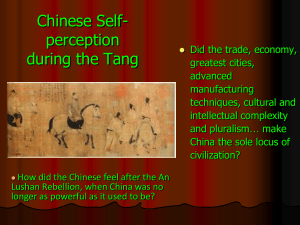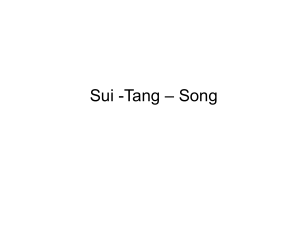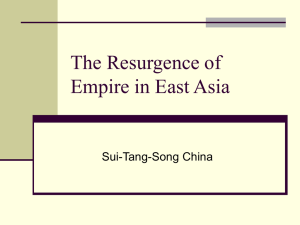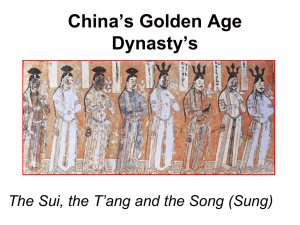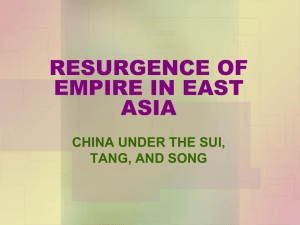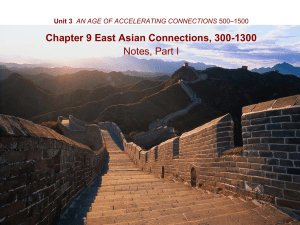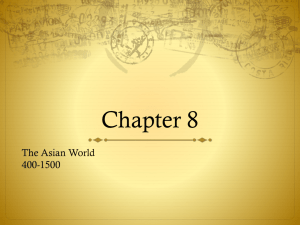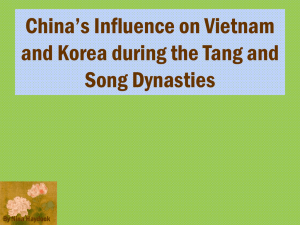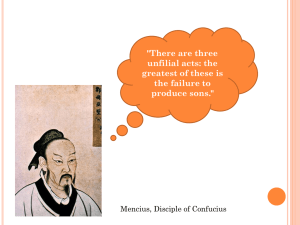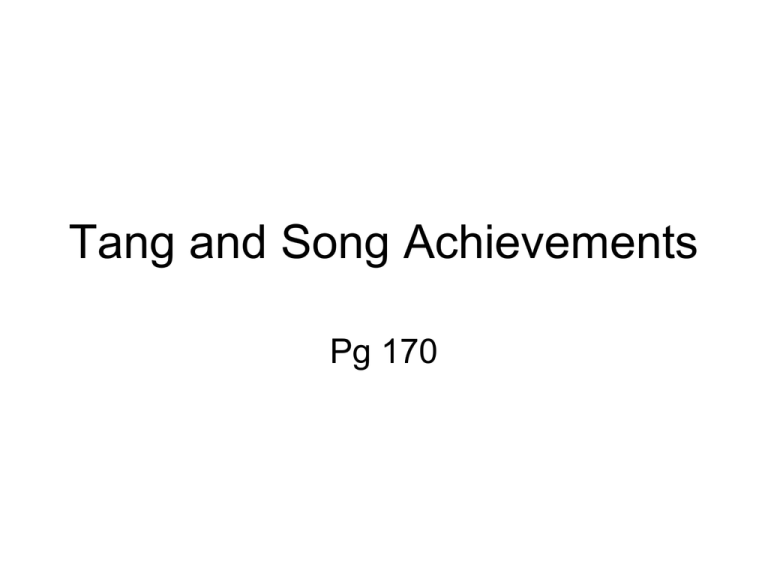
Tang and Song Achievements
Pg 170
• 7.3.2 Describe agricultural, technological,
and commercial developments during the
Tang and Song periods.
• 7.3.5 Trace the historic influence of such
discoveries as tea, the manufacture of
paper, wood-block printing, the compass,
and gunpowder.
• BUILDING BACKGROUND
• The Tang and Song dynasties were
periods of great wealth and progress.
Changes in farming formed the basis for
other advances in Chinese civilization.
• The Tang and Song dynasties were
periods of economic, cultural, and
technological accomplishments.
• 1.Advances in agriculture led to increased
trade and population growth.
• 2.Cities and trade grew during the Tang
and Song dynasties.
• 3.The Tang and Song dynasties produced
fine arts and inventions.
•
•
•
•
Advances in Agriculture
Cities and Trade
City Life
Trade in China and Beyond
– porcelain
• Arts and Inventions
– woodblock printing
– Gunpowder
– compass.
• Artists and Poets
• Important Inventions
• If YOU were there... It is the year 1270.
You are a rich merchant in a Chinese city
of about a million people. The city around
you fills your senses. You see people in
colorful clothes among beautiful buildings.
Glittering objects lure you into busy shops.
You hear people talking—discussing
business, gossiping, laughing at jokes.
You smell delicious food cooking at a
restaurant down the street.
• How do you feel about your city?
• BUILDING BACKGROUND The Tang and
Song dynasties were periods of great
wealth and progress. Changes in farming
formed the basis for other advances in
Chinese civilization.
Advances in Agriculture
• Chinese civilization had always been
based on agriculture. Over thousands of
years, the Chinese had become expert
farmers. In the north farmers grew wheat,
barley, and other grains. In the warmer
and wetter south they grew rice.
•
During the Song dynasty, though,
Chinese farming reached new heights.
The improvement was largely due to new
irrigation techniques. For example, some
farmers dug underground wells. A new
irrigation device, the dragon backbone
pump, allowed one person to do the work
of several. With this light and portable
pump, a farmer could scoop up water and
pour it into an irrigation canal. Using these
new techniques, farmers created elaborate
irrigation systems.
• Under the Song, the amount of land under
cultivation increased. Lands along the
Chang Jiang that had been wild now
became farmland. Farms also became
more productive, thanks to the discovery
of a new type of fast-ripening rice.
Because it grew and ripened quickly, this
rice enabled farmers to grow two or even
three crops in the time it used to take to
grow just one.
•
Chinese farmers also learned to grow
new crops, such as cotton, efficiently.
Workers processed cotton fiber to make
clothes and other goods. The production
of tea, which had been grown in China for
centuries, also increased.
• Agricultural surpluses helped pay taxes to
the government. Merchants also traded
food crops. As a result, food was abundant
not just in the countryside but also in the
cities. Because food was plentiful, China's
population grew. During the Tang dynasty,
the population had been about 60 million.
During the Song dynasty, the farmers of
China fed a country of nearly 100 million
people. At the time, China was the largest
country in the world.
Rice has long been a vital crop in southern China, where the
warm, wet climate is perfect for rice growing.
Copyright © by Holt, Rinehart and Winston. All rights
reserved. Terms of Use. Credits. Privacy Policy.
• Cities and Trade
• Throughout the Tang and Song dynasties,
much of the food grown on China's farms
flowed into the growing cities and towns.
China's cities were crowded, busy places.
Shopkeepers, government officials,
doctors, artisans, entertainers, religious
leaders, and artists made them lively
places as well.
• City Life
• China's capital and largest city during the Tang dynasty
was Chang'an (chahng-AHN), a huge, bustling trade
center. With a population of more than a million, it was
by far the largest city in the world at the
time.
Chang'an, like other trading cities, had a mix of
people from many cultures—China, Korea, Persia,
Arabia, and Europe. It was also known as a religious and
philosophical center, not just for Buddhists and Daoists
but for Asian Christians as well.
•
Cities continued to grow under the Song. Several
cities, including the northern Song capital, Kaifeng (KYfuhng), had about a million people. A dozen more had
populations of close to half a million.
• Trade in China and Beyond
• Trade grew along with Chinese cities. This trade,
combined with China's agricultural base, made China
richer than ever before.
•
Much trade took place within China itself. Traders
used the country's rivers to ship goods on barges and
ships.
•
The Grand Canal, a series of waterways that linked
major cities, carried a huge amount of trade goods,
especially farm products. Construction on the canal had
begun during the Sui dynasty. During the Tang dynasty,
it was improved and expanded. The Grand Canal
allowed the Chinese to move goods and crops from
distant agricultural areas into cities.
• The Chinese also carried on trade with other
lands and peoples. During the Tang dynasty,
most foreign trade was over land routes leading
west to India and Southwest Asia, though
Chinese traders also went to Korea and Japan
in the east. The Chinese exported many goods,
including tea, rice, spices, and jade. However,
one export was especially important—silk. So
valuable was silk that the Chinese tried to keep
the method of making it secret. In exchange for
their exports, the Chinese imported different
foods and plants, wool, glass, gold, and silver.
• During the Song dynasty, maritime trade,
or sea trade, became more important.
China opened its Pacific ports to foreign
traders. The sea-trade routes connected
China to many other countries. During this
time, the Chinese also developed another
valuable product—a thin, beautiful type
of pottery called porcelain.
• All of this trade helped create a strong
economy. As a result, merchants became
important members of Chinese society
during the Song dynasty. Also as a result
of the growth of trade and wealth, the
Song invented the world's first system of
paper money in the 900s.
• Arts and Inventions
• While China grew rich economically, its
cultural riches also increased. In literature,
art, and science, China made huge
advances.
• Artists and Poets
• The artists and writers of the Tang dynasty
were some of China's greatest. Wu
Daozi (DOW-tzee) painted murals that
celebrated Buddhism and nature. Li Bo
and Du Fu wrote poems that readers still
enjoy for their beauty. This poem by Li Bo
expresses the homesickness that one
feels late at night:
• “Before my bed
there is bright moonlight
So that it seems
like frost on the ground:
Lifting my head
I watch the bright moon,
Lowering my head
I dream that I'm home”
•
–Li Bo, "Quiet Night Thoughts"
• Also noted for its literature, the Song
period produced Li Qingzhao (chingZHOW), perhaps China's greatest female
poet. She once said that the purpose of
her poetry was to capture a single moment
in time.
•
Artists of both the Tang and Song
dynasties made exquisite objects in clay.
Tang figurines of horses clearly show the
animals' strength. Song artists made
porcelain items covered in a pale green
glaze called celadon (SEL-uh-duhn).
• Important Inventions
• The Tang and Song dynasties produced
some of the most remarkable—and most
important—inventions in human history.
Some of these inventions influenced
events around the world.
• According to legend, a man named Cai
Lun invented paper in the year 105 during
the Han dynasty. A later Tang invention
built on Cai Lun's achievement—
woodblock printing, a form of printing
in which an entire page is carved into a
block of wood. The printer applies ink to
the block and presses paper against the
block to create a printed page. The world's
first known printed book was printed in this
way in China in 868.
• Another invention of the Tang dynasty was
gunpowder Gunpowder is a mixture of
powders used in guns and explosives.
It was originally used only in fireworks, but
it was later used to make small bombs and
rockets. Eventually, gunpowder was used
to make explosives, firearms, and
cannons. Gunpowder dramatically altered
how wars were fought and, in doing so,
changed the course of human history.
• One of the most useful achievements of Tang
China was the perfection of the magnetic
compass. This instrument, which uses the
earth's magnetic field to show direction,
revolutionized travel. A compass made it
possible to find direction more accurately than
ever before. The perfection of the compass had
far-reaching effects. Explorers the world over
used the compass to travel vast distances. The
navigators of trading ships and warships also
came to rely on the compass. Thus, the
compass has been a key factor in some of the
most important sailing voyages in history.
• The Song dynasty also produced many
important inventions. Under the Song, the
Chinese invented movable type. Movable
type is a set of letters or characters that
are used to print books.
• Unlike the blocks used in block printing,
movable type can be rearranged and
reused to create new lines of text and
different pages.
•
The Song dynasty also introduced the
concept of paper money. People were
used to buying goods and services with
bulky coins made of metals such as
bronze, gold, and silver. Paper money was
far lighter and easier to use. As trade
increased and many people in China grew
rich, paper money became more popular.
• SUMMARY AND PREVIEW
• The Tang and Song dynasties were
periods of great advancement. Many great
artists and writers lived during these
periods. Tang and Song inventions also
had dramatic effects on world history. In
the next section you will learn about the
government of the Song dynasty.
Identify facts about the Tang and
Song dynasties.

